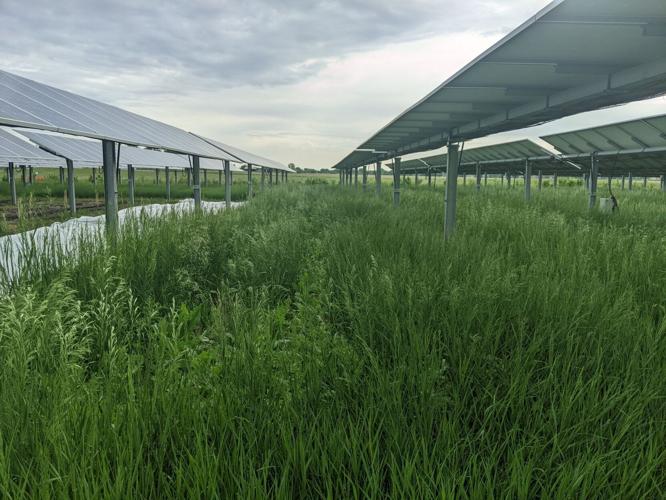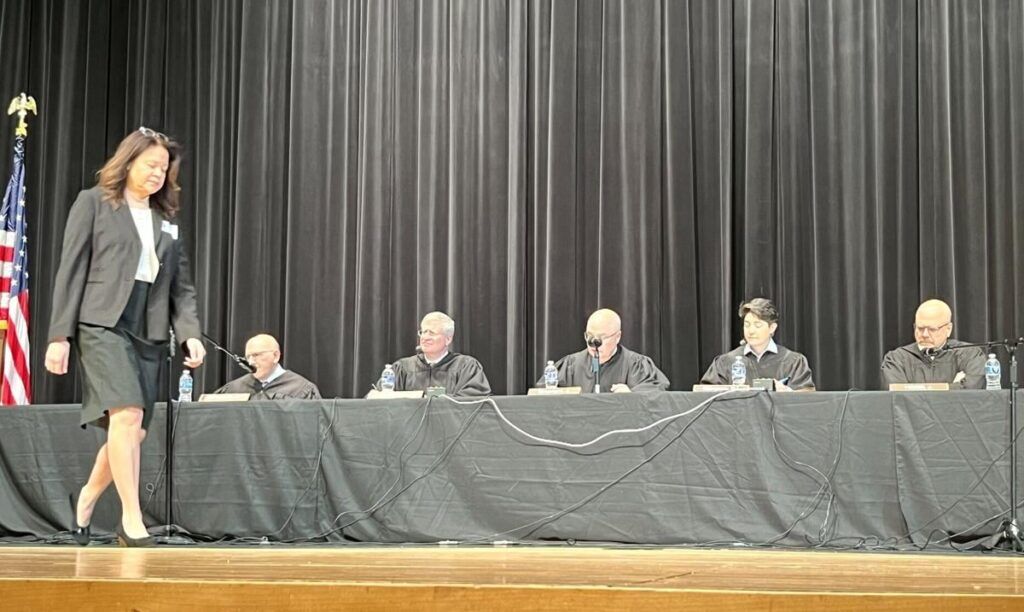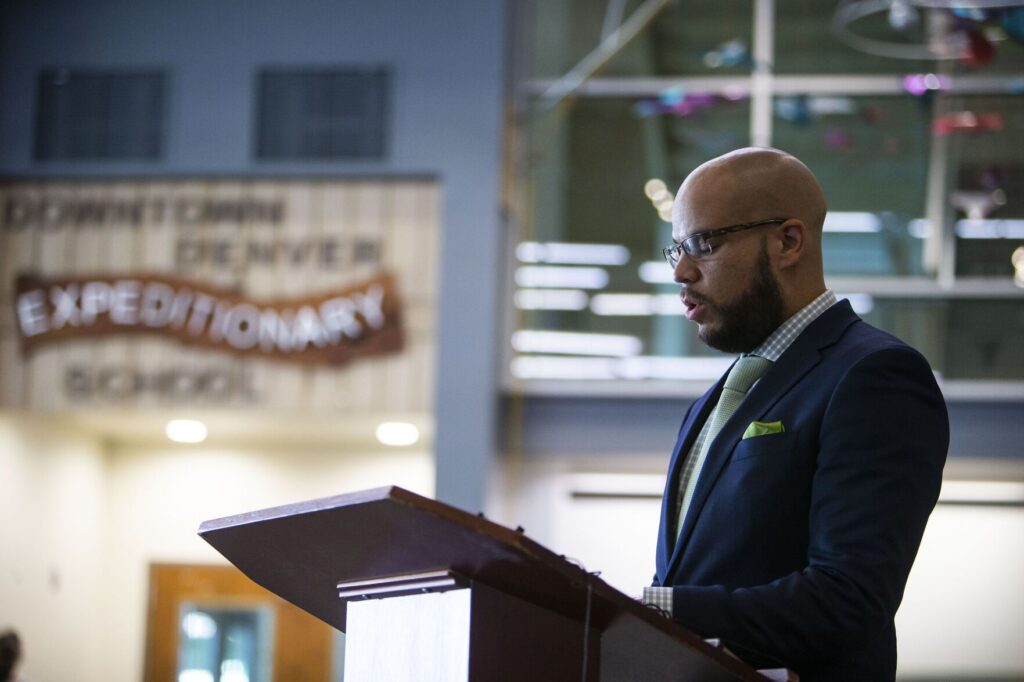Integrating agriculture with solar panels shows promise
“They paved paradise and put up a parking lot,” wrote singer/songwriter Joni Mitchell in 1969, lamenting the view from her hotel window in Hawaii of parking lots “as far as the eye could see,” she said in a 1996 interview with the Los Angeles Times.
Similar concerns are expressed by critics who argue against paving over agricultural properties with solar panels, so the U.S. Department of Agriculture is funding studies to see if solar panels can be successfully integrated with agriculture.
The Sustainably Co-locating Agricultural and Photovoltaic Electricity Systems (SCAPES) project is investigating the interaction between various crops, including grasslands and row crops, and grid-scale solar panel installations.
Matthew Sturchio and Alan K. Knapp, researchers at Colorado State University and Cornell University, just released a study of the impacts of solar panels on the growth of forage grasses during both wet and dry years in Colorado’s arid climate.
The paper concludes that “with climate change projections of increased aridity and drought, PV arrays that reduce plant water stress could provide a unique opportunity to reduce greenhouse gas emissions and mitigate some of their ecosystem consequences in water-limited grasslands.”
The study is part of a multi-state program to examine such effects on a range of crops in different climate zones sponsored by the USDA, which issued a $10 million grant in 2021 to the University of Arizona, Colorado State University, Auburn University, the University of Illinois and the National Renewable Energy Laboratory to study the impacts of combining solar panel generation with agriculture. CSU received $1.1 million for its part.
“I think the USDA mostly was interested in understanding what happens when you put solar into different agricultural landscapes,” Sturchio told the Denver Gazette. “I don’t think they have a motivation to develop crop lands and grasslands with solar, but they do want to know if there are any negative side effects, or what the economics look like.”
Sturchio and Knapp’s initial fieldwork was conducted at Jack’s Solar Garden in Longmont, on a solar panel array covering approximately 4 acres of the 24-acre farm owned by the Kominek family and managed by Byron Kominek.
The farm was purchased by Kominek’s grandfather, Jack Kominek, in 1972. The farm produced hay and wheat. Jack passed away in 1980. Although hay production continued into the summer of 2019, it was no longer economically viable.
Kominek moved to the farm, where he was introduced to solar energy and its potential integration with agriculture.
Kominek installed a solar array, which turned out to be perfect for Sturchio and Knapp’s initial research.
The USDA grant money was partly used to build another solar array on the shortgrass prairie near Nunn, Colorado. Research at the Nunn facility will begin as soon as the array is completed and hooked up to the grid, said Sturchio.
Sturchio explained to The Denver Gazette that his study shows that in dry years, the shade from the solar panels improves grass growth by approximately 88%, while during average and wet years, growth is improved by 28% and 12%, respectively, compared to control sites.
“If you’re talking grasslands in general, if you have a super, super wet year, then there’s not as much of a scarcity in the market for forage for grazing animals,” said Sturchio. “But in dry years, that’s when it becomes pretty tough for ranchers. There’s not as much forage available, so they have to bring in feed from offsite or they have to manage their land a lot differently because there’s not as much available in grasslands.”
“So, in dry years, being able to mitigate some of the losses that you would typically have in production, that’s significantly more important than being able to reduce losses in extra wet years, because in extra wet years, there’s already plentiful forage,” Sturchio added.
The first four-year phase of the project examined the fundamental dynamics between forage grass and solar panels, but Sturchio said the subsequent phases will also investigate solar field design parameters. He noted that factors such as cattle damaging the panels or structures, as well as hail, will be examined at the new Nunn site.
“The panels are racked six feet high, so that’s an industry standard,” said Sturchio. “And then it’s single-axis tracking, which is what most of the new development looks like, where the pivot point on the panels is six feet high, where the torque tubes are, to track the sun across the sky east to west.”
The panels, said Sturchio, dip down to three to four feet above the ground depending on the time of day.
“It was designed to maximize energy production. The one thing that they did, and this is very important, is that they didn’t disturb the soils or the existing vegetation,” said Sturchio. “That’s one of the reasons why we were able to start measurements after the first year.”
The project is also studying the social response to integrating agriculture and solar power. A separate team from the National Renewable Energy Laboratory is exploring the human factors.
“This SCAPES project has several social scientists, economists and engineers associated with it. So, we’re getting a pretty holistic view of what the actual implications are for this type of development.
“There’s always going to be people who just really don’t want anything to be developed,” Sturchio said. “I think that the history of developing any sort of electrical transmission infrastructure has always been an issue of ruining viewsheds. But I think that part of what we’re trying to do is also show that there’s potential synergies, especially in a warmer and drier world, for solar development in grasslands.”
“I think the most important thing is it doesn’t have to be energy or agriculture,” Sturchio said. “You can combine the two. I think that the main takeaway is that it’s not paving paradise. And as we move forward, we’ll know more about plant community dynamics, long-term soil responses, how it affects wildlife, how different insects, avian species, and wildlife in general, interact with these types of sites.”
Colorado Politics Must-Reads:


![Byron_DairyCow[28].jpg](https://www.coloradopolitics.com/wp-content/uploads/2025/06/6848563ab18df.image_-1.jpg)












